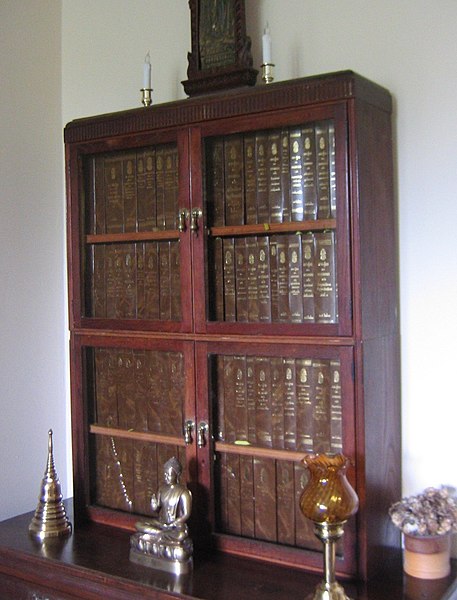LESSON 2921 Mon 4 Mar 2019
Tipitaka - DO GOOD BE MINDFUL is the Essence of the Words of the Awakened One with Awareness
from
Analytic Insight Net - FREE Online Tipiṭaka Law Research & Practice
University
in
112 CLASSICAL LANGUAGES Please Visit: http://sarvajan.ambedkar.org
Brahmajālasuttaṃ
Paribbājakakathā
Brahmajala Sutta
(Discourse on the Net of Perfect Wisdom )
Silakkhandha Vagga, Digha Nikaya, Suttanta Pitaka

 Chulachomklao of Siam Pāḷi Tipiṭaka, 1893, 39 Volumes, in the International Tipitaka Hall
Chulachomklao of Siam Pāḷi Tipiṭaka, 1893, 39 Volumes, in the International Tipitaka Hall
| Place of articulation |
Vowels | Consonants | |||
|---|---|---|---|---|---|
| Vowels | Diphthongs | Stops |
Semivowels | Sibilant | |
| Gutturals | a a | k kh g gh v | h | ||
| Palatals | i i | e | c ch j jh b | y | |
| Cerebrals |
 |
t th d dh n |
r | ||
| Dentals | t th d dh n |
l | s | ||
| Labials | u u | o | p ph b bh m |
v | |
back to index
Alphabets in Dictionary Order
| Vowels | Vowels | a | a |
i | i |
u | u |
| Diphthongs | e | o | |||||
| Consonants | Nasals | j | |||||
| Gutturals | k | kh | g | gh | v | ||
| Palatals | c | ch | j | jh | b | ||
| Cerebrals | t | th | d | dh | n | ||
| Dentals | t | th | d | dh | n | ||
| Labials | p | ph | b | bh | m | ||
| Semivowels | y | r | l | l | lh | v | |
| Sibilants | s | ||||||
| Aspirate | h |
back to index
Pronunciation Practice
Pronunciation of Words
(The English translation of these words is by no means exhaustive)
| Assaji | Assaji (a personal name) |
| arahant | Arahant, Arhat |
| anicca | impermanent |
| atha | then |
| attan | Self |
| ayasmant | Venerable (a title of respect for senior monks) |
| aha | said |
| buddho | Buddha |
| bhagavant | Blessed One (a title used for the uddha) |
| cittaj | mind |
| ca | and |
Pronunciation of Sentences
1) Namaskara
Namo tassa bhagavato arahato sammasajbuddhassa
(Homage to Him, Blessed One, Arahant, truly and completely Awakened One.)
2) Tisarana
buddhaj
saranaj gacchami (I take refuge in the Buddha.)
dhammaj
saranaj gacchami (I take refuge in the Teaching.)
savghaj
saranaj gacchami (I take refuge in the Community.)
3) Dhammapada 354
sabbadanaj
dhammadanaj jinati (The gift of Dharma conquers all gifts.)
sabbarasaj
dhammaraso jinati (The taste of Dharma excels all tastes.)
sabbaratij
dhammarati jinati (The joy of Dharma excels all joys.)
tanhakkhayo sabbadukkhaj
jinati (The destruction of thirst conquers all suffering.)
4) Dhammapada 183
sabbapapassa akaranaj (Not doing the evil deeds,)
kusalassa upasampada (Gathering the wholesome,)
sacittapariyodapanaj (Purifying one’s own mind -)
etaj
buddhana sasanaj (That is teaching of the buddhas.)
5) Vinaya-pitaka,
Mahavagga, I. 40. (5)
atha kho ayasma
Assaji And then Venerable Assaji
Sariputtassa paribbajakassa
to the wandering mendicant Sariputta
imaj
dhammapariyayaj abhasi:
spoke this Dhamma-exposition:
ye dhamma
hetuppabhava Whatever phenomena arise from cause,
tesaj
hetuj tathagato
aha their cause the Tathagata proclaimed.
tesab
ca yo nirodho And what is their cessation.
evajvadi
mahasamano This is the teaching of the Great Contemplative.
6) tini lakkhanani
(a) Aniccalakkhana (Dhammapada
277)sabbe savkhara
anicca ti (”All conditioned things are impermanent,”)
yada
pabbaya passati (when one perceives with wisdom,)
atha nibbindati dukkhe
(then one turns away from suffering.)
esa maggo visuddhiya
(This is the path of purification.)
(b) Dukkhalakkhana (Dhammapada
278)sabbe savkhara
dukkha ti (”All conditioned things are unsatisfactory,”)
yada
pabbaya passati (when one perceives with wisdom,)
atha nibbindati dukkhe
(then one turns away from suffering.)
esa maggo visuddhiya
(This is the path of purification.)
(c) Anattalakkhana (Dhammapada
279)sabbe dhamma anatta ti (”All things are without a Self,”)
yada pabbaya passati (when one perceives with wisdom,)
atha nibbindati dukkhe (then one turns away from suffering.)
esa maggo visuddhiya (This is the path of purification.)
7) Mahaparinibbanasuttanta
Parinibbute Bhagavati saha parinibbana When the Blessed One had passed away, simultaneously with his Parinibbana,
Sakko devanam indo Sakka, king of the gods,
imaj
gathaj abhasi: spoke this stanza:
‘Anicca
vata savkhara, “Transient are all compounded things,
uppada-vaya-dhammino; Subject to arise and vanish;
Uppajjitva nirujjhanti, Having come into existence they pass way;
tesaj vupasamo sukho’ ti. Good is the peace when they forever cease.”
https://www.youtube.com/watch?v=_nGl2l1Ls7U
PALI CONSONANTS PART 1
The People
Published on Aug 1, 2013
PALI CONSONANTS PART 1
Category
Education
https://www.youtube.com/watch?v=rdZwH9YeILA
Learn Basic Pāli Grammar Episode 02: Pāli Vowels
The People
Published on Jun 25, 2016
Hello, and welcome back, in this lesson we are going to study the Pali
Pronunciation. The first thing to know about Pali is that it was an oral
language, it had no script of its own. All Theravada countries has its
own script for Pali and we shall use roman script for this course.
There are 41 letters in Pali, 8 Vowels, and 33 consonants. For this
lesson, we will study 8 Vowels and see how to pronounce them. The eight
Vowels are: a, ā, i, ī, u, ū, e, o.
A= cut=Dhamma
Ā=Father =Dāna
I=east=Sila
Ī=Bee=Dīgha
U=oops=Sutta
Ū=Cool=Bhūpāla
E=Pay=Nare
O=Open=Putto
Category
Education
A Course in the Pali Language
Aug 2, 2008 | Audios
Pali
is the language used to preserve the Buddhist canon of the Theravada
Buddhist tradition, which is regarded as the oldest complete collection
of Buddhist texts surviving in an Indian language. Pali is closely
related to Sanskrit, but its grammar and structure are simpler.
Traditional Theravadins regard Pali as the language spoken by the Buddha
himself, but in the opinion of leading linguistic scholars, Pali was
probably a synthetic language created from several vernaculars to make
the Buddhist texts comprehensible to Buddhist monks living in different
parts of northern India. It is rooted in the Prakrits, the vernacular
languages, used in northern India during the Middle period of Indian
linguistic evolution. As Theravada Buddhism spread to other parts of
southern Asia, the use of Pali as the language of the texts spread along
with it, and thus Pali became a sacred language in Sri Lanka, Myanmar,
Thailand, Laos, Cambodia and Vietnam. Pali has been used almost
exclusively for Buddhist teachings, although many religious and literary
works related to Buddhism were written in Pali at a time when it was
already forgotten in India. This course is designed to help you to
learn the basics of Pali grammar and vocabulary through direct study of
selections from the Buddha’s discourses. It thus aims to enable you to
read the Buddha’s discourses in the original as quickly as possible. The
textbook for the course is A New Course in Reading Pali: Entering the
Word of the Buddha by James Gair and W.S. Karunatilleke (1998, Motilal
Banarsidass Publishers, Delhi, India. ISBN 81-208-1440-1). The Pali
grammatical tables were designed by Bhikkhu Nyanatusita.
The course proceeds sequentially through the chapters, or “Lessons,” in the textbook, each of which has three parts:
An initial set of readings and an accompanying glossary
Grammatical notes on the forms in the lesson
A set of further readings and a glossary
The
lectures will be much more meaningful if the listener obtains a copy of
the textbook and studies each lesson before listening to the associated
set of lectures. Also, the textbook and lectures assume that the
listener has a fundamental understanding of grammar. For those whose who
feel that their knowledge of grammar needs refreshing, we recommend
Pali Grammar for Students by Steven Collins (2006, Silkworm Books, ISBN
978-974-9511-13-8).
Lesson I
Lecture 1
Lecture 2
Lecture 3
Lecture 4
Recital of Initial Readings
Recital of Further Readings
Lesson II
Lecture 5
Lecture 6
Recital of Initial Readings
Recital of Further Readings
Lesson III
Lecture 7
Lecture 8
Lecture 9
Recital of Initial Readings
Recital of Initial Readings
Lesson IV
Lecture 10
Lecture 11
Lecture 12
Lecture 13
Recital of Initial Readings
Recital of Further Readings
Lesson V
Lecture 14
Lecture 15
Recital of Initial Readings
Recital of Further Readings
Lesson VI
Lecture 16
Lecture 17
Lecture 18
Lecture 19
Recital of Initial Readings
Recital of Further Readings
Lesson VII
Lecture 19
Lecture 20
Lecture 21
Lecture 22
Lesson VIII
Lecture 23
Lecture 24
Lecture 25
Lecture 25
Lecture 26
Lesson IX
Lecture 27
Lecture 28
Lecture 29
Lecture 30
Lesson X
Lecture 31
Lecture 32
Lecture 33
Lecture 34
Lesson XI
Recital of Initial Readings
Recital of Further Readings
Vinayapiṭaka
Suttapiṭaka
Dīghanikāya
Sīlakkhandhavaggapāḷi
1. Brahmajālasuttaṃ
COMPREHENCIVE PALI COURSE
INTRODUCTION
The Comprehensive Pāḷi Course contains
instructions on all aspects of the
study of Pāḷi language including grammar, composition and syntax. It is intended for all those who want to learn Pāḷi language, one of the three classical languages of Prabuddha Bharath,
the other two being Sanskrit and Prakrit. Lord Buddha taught in Pāḷi language which is also known as Māgadhi.
Pāḷi was spoken in the
Indo-gangetic plain now covered by Bihar, Uttar Pradesh, Bengal
and some parts of Madhya Pradesh. Buddha delivered His messagein Pāḷi,
the language which both the elite and the ordinary people could master,
so that the spirit of His Dhamma could enrich the minds of all. In this
way Pāḷi played a historical rolein a practical manner through centuries and, indeed, it does even today in all the Buddhist countries.
The study
of Pāḷi
is not only important but an imperative to have a clear and objective
grasp of history of Prabuddha Bharath and linguistics. All over the
world it is being studied. Only in Prabuddha Bharath, due to
lack of facilities, and, it is regrettable to say, sectarian
bias, the rightful place of Pāḷi has not been restored.
The
Comprehensive Pāḷi Course is intended to introduce the students of Prabuddha Bharath linguistics into
the rich heritage of Pāḷi language and
literature. This course is complete by itself. The answers of the lessons given in the end of the
book.
The course
was prepared in 1954, when I taught at the Pali Post-Graduate Institute
at Nalanda. Thereafter it was used to instruct the students undergoing
course in Pāḷi studies and Buddhology in Bangalore.
This book
is being considered as the text for students of Pāḷi language at different universities, in Karnataka under the auspicious of Mahabodhi Buddhist Open University and Mahabodhi
Monastic Academy,
Bangalore.
Bangalore, 1995
Venerable
Acharya Buddharakkhita
THE PALI LANGUAGE
Pāḷi means “Buddha Vacanam”, the word of the Buddha consisting
the texts of the Tipitaka, the sacred Buddhist Canon,containing the original teachings of the
Buddha. Hence we come across
the phrase, “Imaṁ tāva pāliyam, aṭṭhakathāyam pana” which occur in the texts of Tipitaka. In the
commentaries however …”.
In Pāḷi lexicon the definition of Pāḷi is given thus: “Pa-paleti, rakkhati ti Pāḷi: since it
preserves the the ‘Buddha Vacana’ in the form of the
sacred texts. It is called Pāḷi.
As to the origin of Pāḷi, Emperor Ashoka has left an evidence in his Bhabhri edict, “Imāni bhanteDhammapaliyāyāni: These,
Venerable Sir, are the texts of the Dhamma.” In
course of time, paliyāyā became Pāḷi, an elliptical form. The home of Pāḷi is Magadha. That is why it is also known as Māgadhi. “Sammāsambuddhene vuttappakāra māgadhiko vohāro
–
The Māgadhi medium used by the
Supremely Awakened One.” The Māgadhi language
was the lingua franca of region comprising Bihar, parts of Assam,
Bengal, Orissa, Uttar Pradesh and Madhya Pradesh, and area otherwise called
Gangetic plain, washed and fertilized by two river
systems, Ganga and Yamuna.
The Buddha
purposely did not speak in Chandas, the language of Vedas, also called
as Vedic Sanskrit. He spoke in the language of the common people. “Anujānāmi bhikkhave
sakāyaniruttiā Buddhavacanaṁ pariyāpunitaṁ - Monks, I instruct that the words
of the Buddha are learnt in the
standard vernacularof the masses.”
It is quiet obvious that had the Buddha given instructions in Vedic
Sanskrit, Buddhism would have become distorted and
turned into another Theistic doctrine beyond the
grasp of common people, accessible only to the elite class.
This is one reason, why Pāḷi is subjected to step-motherly treatment by sanskritists.
In the
interest of Sanskrit, at least classical Sanskrit, which is widely studied today. Pāḷi should be propagated as a sister discipline. This apart, chronologically, Pāḷi is decidedly older than modern classical Sanskrit.
It is hoped
that in the age of science and technology when language studies
are becoming more and more objective, Pāḷi should be studied widely as a discipline inseparable from other classical languages of Prabuddha
Bharath.
Alphabet and Pronunciation
Alphabet:
The Pāḷi alphabet consist of 41 letters: 8
sara (vowels), the niggahīta (ṁ),
and 32 byanjana
(consonants).
|
Vowels: |
a, ā, |
|
Niggahīta: |
ṁ |
|
Consonants: |
k, kh, p, ph, |
Pronunciation: (pronounced similar to the example)
|
a |
as in but, |
|
ā |
as in father, |
|
i |
as in bit, |
|
ī |
as in |
|
u |
as in put, |
|
ū |
as in rude, |
|
e |
as in way, consonant |
|
o |
as in home, double |
|
|
|
|
ṁ |
as ṅ or m - pure nasal without (It is produced is emitted through the nose only. There are |
|
|
|
|
k |
as in skin, |
|
kh |
as in king, |
|
g |
as in girl, |
|
gh |
as in log-head, |
|
ṅ |
as in sing, |
|
c |
as in |
|
ch |
as in ranch-house, |
|
j |
as in |
|
jh |
as in hedge-hog |
|
ñ |
as |
|
ṭ |
as t hard |
|
ṭh |
as th hard |
|
ḍ |
as d hard |
|
ḍh |
as dh hard |
|
ṇ |
as n hard |
|
t |
as in stay, back of |
|
th |
as in at the |
|
d |
as in dog, back of the teeth) |
|
dh |
as in mad-house, at the |
|
n |
as in name, the back |
|
p |
as in space, |
|
ph |
as in top-hat, |
|
b |
as in bag, |
|
bh |
as in lab-host, |
|
m |
as in him, |
|
y |
as in yes, |
|
r |
as in ram, to english r, retroflex prositioning) |
|
l |
as in lamp, |
|
ḷ |
same as l the hard |
|
v |
a v and w. |
|
s |
as in sit, |
|
h |
as in inherent, |
the
digraphs dh, etc., are to be taken as single sounds, the h
representing
aspiration - double consonants are pronounced
seperately
the first having no release): example - dd in mad
dog, gg in big game,
etc., or pronounced long: example - nn
in
unnecessary
LESSON 1
The Pāḷi language consists of 41 letters of which 8 are sara (vowels) and 33 are
byanjana (consonants).
Vowels: a,
ā, i, ī, u, ū, e, o
Of these
a, i, u are short and ā, i, ū are long;
e, o may be
either
short or long, according to the context.
Consonants
: Gutterals (Ka-vagga) : k, kh, g, gh, ṅ,
Palatals (ca-vagga) : c,
ch, j, jh, ñ,
Cerebrals (ta-vagga) : ṭ, ṭh, ḍ, ḍh, ṇ,
Dantals (ta-vagga) : t,
th, d, dh, n,
Labials (pa-vagga) :
p, ph, b, bh, m,
Aspirate : y, r, l, v,
Niggahīta: : s, h, ḷ, a, ṁ
Parts of
speech:
There
are four parts of speech in Pāḷi :
1. Nāma = Noun.
2. Akkāta = Verb.
3. Upasagga = Prefix.
4. Nipāta = indeclinable particles,
such as, Conjunctions,
prepositions, adverbs etc.
Adjectives
are treated as nons because they areSimilarly declined.
Genders:
There are 3 genders (linga) in Pāḷi language, viz.,
1. Pullingga = Masculine gender.
2. Itthilinga = Feminine
gender.
3. Napumsakalinga = Neuter
gender.
Nouns
which denote males are masculine and
Those which denote females are
feminine. But qualities and inanimate things are not
necessarily neuter.Therefore, gender in Pāḷi is only a
grammatical distinctionexisting in words.
Numbers:
In Pāḷi there are two numbers (vacana):
1. Ekavacana = Singular
number.
2. Bahuvacana = plural numbers.
Pāḷi does not have dual,
as found in Sanskrit.
This makes Pāḷi simpler.
Cases:
There are 8 cases in Pāḷi:
1. Paṭhamā vibhatti = Nominative case = subject
2. Dutiyā vibhatti =
Accusative case = Object
3.Tatiyā vibhatti =
Instrumental case (prepositions)
=
by, with,through
4. Catuthṭ vibhatti = Dative case = to, far
5. Pancami vibhatti = Ablative
case = from
6. Chaṭṭhī vibhatti = Genitive/possessive case = of
7. Sattamī vibhatti = Locative
case =on, in, at,
Among,
amidst
8. Alapana vibhatti = Vocative case = Oh, etc.
Nouns
are declined according th the genders,Numbers and cases.
LESSON 2
Declension of nouns (Nāma vibhatti)Masculine gender (Noun ending in a)
Vibhatti Singular Plural
1. Paṭhamā : 0 ā
2.
Dutiyā : aṁ e
3. Tatiyā : ena ebhi,
ehi
4. Catuthṭ : assa, āya ānaṁ
5. Pancami : ā, asmā, amhā, to ebhi, ehi
6. Chaṭṭhī ; assa ānaṁ
7. Sattamī : e, asmiṁ, amhi esu
8. Alapana : a ā
For
example: Buddha = The awakened One.
Vibhatti Singular Plural
1. Paṭhamā : Buddho Buddhā
2.
Dutiyā : Buddhaṁ Buddhe
3. Tatiyā : Buddhena(by) Buddhebhi, Buddheni
4. Catutthī : Buddhaassa (to)
Buddhāya (for)
5. Pancami : Buddhā, Buddhebhi,Buddheni
Buddhasmā
(from)
Buddhamhā
Buddhato
6. Chaṭṭhī ; Buddhassa
(of) Buddhānaṁ
7. Sattamī : Buddhe (on) Buddhesu
Buddhasmiṁ (in)
Buddhamhi
(at)
8. Alapana : Buddha!
(oh) Buddhā
Vocabulary
: The following words are similarly declined:
Buddha =
The Awakened One Paṇḍita = wise One
Dhamma =
The teachings of the Sāvaka =
Disciple
Buddha, Truth Lobha = Greed
Sañgha =
Order of the Buddha’s Vihāra =
Monastery
Monastic disciples Dosa = Hatred
Samaṇa = Monk Pāda = foot
Bāla =
Fool Moha
= Delusion
Dāraka =
Boy Acariya
= Teacher
Gāma =
Village Manussa
= Man
Magga =
Path Loka
= World
03)Magadhi Prakrit,
05) Classical Pali,
06) Classical Devanagari,Classical Hindi-Devanagari- शास्त्रीय हिंदी,
07) Classical Cyrillic
08) Classical Afrikaans– Klassieke Afrikaans
09) Classical Albanian-Shqiptare klasike,
10) Classical Amharic-አንጋፋዊ አማርኛ,
11) Classical Arabic-اللغة العربية الفصحى
12) Classical Armenian-դասական հայերեն,
13) Classical Azerbaijani- Klassik Azərbaycan,
14) Classical Basque- Euskal klasikoa,
15) Classical Belarusian-Класічная беларуская,
16) Classical Bengali-ক্লাসিক্যাল বাংলা,
17) Classical Bosnian-Klasični bosanski,
18) Classical Bulgaria- Класически българск,
19) Classical Catalan-Català clàssic
20) Classical Cebuano-Klase sa Sugbo,
21) Classical Chichewa-Chikale cha Chichewa,
22) Classical Chinese (Simplified)-古典中文(简体),
23) Classical Chinese (Traditional)-古典中文(繁體),
24) Classical Corsican-Corsa Corsicana,
25) Classical Croatian-Klasična hrvatska,
26) Classical Czech-Klasická čeština,
27) Classical Danish-Klassisk dansk,Klassisk dansk,
28) Classical Dutch- Klassiek Nederlands,
29) Classical English,Roman
30) Classical Esperanto-Klasika Esperanto,
31) Classical Estonian- klassikaline eesti keel,
32) Classical Filipino,
33) Classical Finnish- Klassinen suomalainen,
34) Classical French- Français classique,
35) Classical Frisian- Klassike Frysk,
36) Classical Galician-Clásico galego,
37) Classical Georgian-კლასიკური ქართული,
38) Classical German- Klassisches Deutsch,
39) Classical Greek-Κλασσικά Ελληνικά,
40) Classical Gujarati-ક્લાસિકલ ગુજરાતી,
41) Classical Haitian Creole-Klasik kreyòl,
42) Classical Hausa-Hausa Hausa,
43) Classical Hawaiian-Hawaiian Hawaiian,
44) Classical Hebrew- עברית קלאסית
45) Classical Hmong- Lus Hmoob,
46) Classical Hungarian-Klasszikus magyar,
47) Classical Icelandic-Klassísk íslensku,
48) Classical Igbo,
49) Classical Indonesian-Bahasa Indonesia Klasik,
50) Classical Irish-Indinéisis Clasaiceach,
51) Classical Italian-Italiano classico,
52) Classical Japanese-古典的なイタリア語,
53) Classical Javanese-Klasik Jawa,
54) Classical Kannada- ಶಾಸ್ತ್ರೀಯ ಕನ್ನಡ,
55) Classical Kazakh-Классикалық қазақ,
56) Classical Khmer- ខ្មែរបុរាណ,
57) Classical Korean-고전 한국어,
58) Classical Kurdish (Kurmanji)-Kurdî (Kurmancî),
59) Classical Kyrgyz-Классикалык Кыргыз,
60) Classical Lao-ຄລາສສິກລາວ,
61) Classical Latin-LXII) Classical Latin,
62) Classical Latvian-Klasiskā latviešu valoda,
63) Classical Lithuanian-Klasikinė lietuvių kalba,
64) Classical Luxembourgish-Klassesch Lëtzebuergesch,
65) Classical Macedonian-Класичен македонски,
66) Classical Malagasy,
67) Classical Malay-Melayu Klasik,
68) Classical Malayalam-ക്ലാസിക്കൽ മലയാളം,
69) Classical Maltese-Klassiku Malti,
70) Classical Maori-Maori Maori,
71) Classical Marathi-क्लासिकल माओरी,
72) Classical Mongolian-Сонгодог Монгол,
73) Classical Myanmar (Burmese)-Classical မြန်မာ (ဗမာ),
74) Classical Nepali-शास्त्रीय म्यांमार (बर्मा),
75) Classical Norwegian-Klassisk norsk,
76) Classical Pashto- ټولګی پښتو
77) Classical Persian-کلاسیک فارسی
78) Classical Polish-Język klasyczny polski,
79) Classical Portuguese-Português Clássico,
80) Classical Punjabi-ਕਲਾਸੀਕਲ ਪੰਜਾਬੀ,
81) Classical Romanian-Clasic românesc,
82) Classical Russian-Классический русский,
83) Classical Samoan-Samoan Samoa,
84) Classical Scots Gaelic-Gàidhlig Albannach Clasaigeach,
85) Classical Serbian-Класични српски,
86) Classical Sesotho-Seserbia ea boholo-holo,
87) Classical Shona-Shona Shona,
88) Classical Sindhi,
89) Classical Sinhala-සම්භාව්ය සිංහල,
90) Classical Slovak-Klasický slovenský,
91) Classical Slovenian-Klasična slovenska,
92) Classical Somali-Soomaali qowmiyadeed,
93) Classical Spanish-Español clásico,
94) Classical Sundanese-Sunda Klasik,
95) Classical Swahili,
96) Classical Swedish-Klassisk svensk,
97) Classical Tajik-тоҷикӣ классикӣ,
98) Classical Tamil-பாரம்பரிய இசைத்தமிழ் செம்மொழி,
99) Classical Telugu- క్లాసికల్ తెలుగు,
100) Classical Thai-ภาษาไทยคลาสสิก,
101) Classical Turkish-Klasik Türk,
102) Classical Ukrainian-Класичний український,
103) Classical Urdu- کلاسیکی اردو
104) Classical Uzbek-Klassik o’zbek,
105) Classical Vietnamese-Tiếng Việt cổ điển,
106) Classical Welsh-Cymraeg Clasurol,
107) Classical Xhosa-IsiXhosa zesiXhosa,
108) Classical Yiddish- קלאסישע ייִדיש
110) Classical Zulu-I-Classical Zulu
Voice of All Awakened Aboriginal Societies (VoAAAS)
http://www.picturesanimations.com/e/elephant/14anim.gif

http://www.ambedkar.org/gifimages/voteforBSP.gif

Maha Sathipattana Suthraya - මහා සතිපට්ඨාන සුත්රය -
LESSONS
https://www.youtube.com/watch?
for
Maha-parinibbana Sutta — Last Days of the Buddha
The Great Discourse on the Total Unbinding
This
wide-ranging sutta, the longest one in the Pali canon, describes the
events leading up to, during, and immediately following the death and
final release (parinibbana) of the Buddha. This colorful narrative
contains a wealth of Dhamma teachings, including the Buddha’s final
instructions that defined how Buddhism would be lived and practiced long
after the Buddha’s death — even to this day. But this sutta also
depicts, in simple language, the poignant human drama that unfolds among
the Buddha’s many devoted followers around the time of the death of
their beloved teacher.
https://www.youtube.com/watch?
for
Mahāsatipaṭṭhānasuttaṃ (Pali) - 2 Kāyānupassanā ānāpānapabbaṃ
http://www.buddha-vacana.org/
Use
http://www.translate.google.
Rector
JC
an expert who identifies experts influenced by Expert and Infulencer Sashikanth Chandrasekharan
of
Awaken One With Awareness Mind
(A1wAM)+ ioT (insight-net of Things) - the art of Giving, taking and Living to attain Eternal Bliss
as Final Goal through Electronic Visual Communication Course on
Political Science -Techno-Politico-Socio Transformation and Economic
Emancipation Movement (TPSTEEM).
Struggle hard to see that all fraud EVMs are replaced by paper ballots by
Start
using Internet of things by creating Websites, blogs. Make the best use
of facebook, twitter etc., to propagate TPSTEEM thru FOA1TRPUVF.
Practice
Insight Meditation in all postures of the body - Sitting, standing,
lying, walking, jogging, cycling, swimming, martial arts etc., for
health mind in a healthy body.
from
Analytic Insight Net - Online Tipiṭaka Law Research & Practice University
in
112 CLASSICAL LANGUAGES
Online Tipiṭaka Law Research & Practice University
in
112 CLASSICAL LANGUAGES
Paṭisambhidā Jāla-Abaddha Paripanti Tipiṭaka nīti Anvesanā ca
Paricaya Nikhilavijjālaya ca ñātibhūta Pavatti Nissāya
http://sarvajan.ambedkar.org anto 112 Seṭṭhaganthāyatta Bhās
through
 http://sarvajan.ambedkar.org
http://sarvajan.ambedkar.org

buddhasaid2us@gmail.com
jchandra1942@icloud.com
sarvajanow@yahoo.co.in
Transformation and Economic Emancipation Movement followed by millions
of people all over the world in 112 Classical languages.
Rendering exact translation as a lesson of this
University in one’s mother tongue to this Google Translation and
propagation entitles to become a Stream Enterer (Sottapanna) and to attain Eternal Bliss as a Final Goal
|
SARVA SAMAJ MEDIA
for
WELFARE, HAPPINESS AND PEACE
of
ALL SOCIETIES
From
MEDIA PRABANDHAK
JC  MEDIA
PRABANDHAK
|
|
|

